Japanese
English
- 有料閲覧
- Abstract 文献概要
- 1ページ目 Look Inside
- サイト内被引用 Cited by
要旨 1年以上の間隔で2回以上の注腸X線検査が施行され,国立がんセンターにて切除された大腸癌18例20病変を対象とした.これらの病変についてX線学的に,大きさおよび形態上の推移,doubling time,発育パターンを検討し,以下の知見と推論を得た.①切除時に早期癌であった群のdoubling timeの平均は51.7か月,進行癌であった群では11.4か月であった.②3回以上の注腸検査歴があった進行癌の3例で,腫瘍径の増大をみると,発育パターンは直線ではなく,二次曲線に近いものであった.③進行癌になった群では,発育速度は病変の大きさに比例して,速くなる傾向がみられた.④進行癌の初期像と思われる13病変中10病変は,6~15mm大の無茎の隆起性病変であった.⑤進行癌へと発育・進展してゆく主経路は,無茎の隆起性病変が有茎になることなく,そのまま無茎の早期癌を経て,進行癌になる経路であろうと思われる.
Time-sequential observation is important to study changes of some lesions. However, it is not permited for malignant neoplasms to follow time-sequential changes, and retrospective study is the main measures for studying their changes. Therefore, cases of colorectal cancer, which can be studied retrospectively for years, are very important to estimate a natural history of the colorectal cancer.
We have studied 20 lesions in 18 cases of colon cancer which had barium enema more than twice at more than one-year interval, and resected their lesions at National Cancer Center Hospital. They included seven lesions of early cancer and 13 lesions of advanced cancer. Male and female cases were ten and eight respectively and their ages ranged from 48 to 77 years old.
We investigated the above lesions by studying their sizes and morphological changes roentgenologically, doubling time and growth patterns. The following results and presumption were obtained.
1)In cases of early cancer, which invasion is limited to mucosal propria (m) or submucosal layer (sm), the doubling time was average 51.7 months. On the other hand, in advanced cancer which invasion is beyond the muscle laver (pm), the doubling time was average 11.4 months.
2)In three cases of advanced cancer, which had barium enema more than three times, the growth pattern was not linear but close to a curve of the second order line.
3)In advanced cancer, the growth rate tend to become faster when its size gets bigger.
4)In 13 lesions which were felt to be the early stage of advanced cancer, ten of them showed sessile lesions with 6-15mm in size.
5)The main growth pathway to advanced cancer was suggested to be the followings: namely, the sessile lesion become advanced cancer via a sessile type of early gastric cancer without forming stalk.

Copyright © 1985, Igaku-Shoin Ltd. All rights reserved.


